Artopia: November 2007 Archives
..............REVIEWS OF MARTIN PURYEAR, ALAN SHIELDS,
MORIKO MORI, AND ALAN SARET.....

Martin Puryear, Old Mole, 1985.
Lumber Art
The Martin Puryear retrospective at MoMA (11 West 53rd St., to Jan. 14, 2008) presents a panoply of engaging sculptures. The large-scale pieces in the second-floor atrium conquer that unfriendly, gigantic-broom-closet space. If you look up, you normally feel you need to avoid bird-droppings; if you look down from the sixth-floor walkway, you want to jump. Miraculously, the suspended 36-foot Ladder for Booker T. Washington (1996) and the slender 63-foot stalk of the wheeled Ad Astra (2007) conquer the architectural mistake. The horizontally deployed but enormous Desire (1981), with its big wagon-wheel linked to an inverted basketry cone, anchors Puryear's atypical forays into extreme height.
Should we consider that Puryear is African American? It's hard to avoid. Titles such as Ladder for Booker T. Washington would give it away in any case. And the works themselves? Puryear's links to craft traditions and his sensitivity to wood would not by themselves point to his ethnic background. Cultural background? His obviously includes Miro, Brancusi, Noguchi and the Minimalists.
Many of Puryear's sculptures are organic Minimalism with a twist: a carefully constructed single image that is allowed to morph into a sculpture with a beak or tail, as in Old Mole (1985) The hollow interiors, unlike any plywood Robert Morris, are often exposed. You can peek inside. Such is the case with Bower(1980), Mus(1984), Thicket (1990), and Brunhilde (1998-2006).
We could also think of Puryear's cool but playful sculptures as outsize H. C. Westermanns, minus the autobiographical yarns and the jokes. Puryear has that kind of hands-on feeling for wood, but he goes much further than carpentry to embrace the techniques of yurt building and basketry. His work is cross-cultural and refined.
Puryear's language includes studied awkwardness, as in Lever #1 (1988-89), Lever # 2 (1989), and In Sheep's Clothing (1996); the use of several kinds of identifiable wood, often in contrast to metal mesh or odd materials like pitch, which, of course, comes from evergreen trees; and the appropriation or quotation of a myriad of woodworking and building techniques, basketry, and even leatherworking, sometimes in reference to particular cultures.
The panoply of mid-sized sculptures - more massive than a person but no taller than most who will circle these obdurate constructions -- and wall pieces (horizontal lines of wood, lines of twisted rawhide and hair, hoops) on MoMA's 6th floor present the solid working out of these themes --- with finesse and, yes,
humor.
Don't be tricked into comparing him with Richard Serra, whose spectacular torqued battleship hulls were last on the bill. Although Serra's scary giants will forever haunt the sixth-floor exhibition space, succession in programming does not mean comparisons are required. Puryear's art belongs to an entirely different universe.
SCROLL DOWN FOR OTHER REVIEWS
For an Automatic Artopia Alert when new topics are posted, e-mail Perreault@aol.com.
Alan Shields Returns
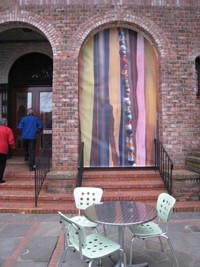
Entrance to Parrish Art Museum, Southhampton, L.I., N.Y.
Glitter Can Be Gold
Alan Shields (1944-2005) is one of those artists who disappeared. After a flashy start at Paula Cooper, he deserted the art world for the North Fork of Long Island and became a pilot of the Shelter Island Ferry.
For those not in the know, the North Fork is definitely not the South Fork. Although Native Americans pictured their Long Island as a fish with its mouth about to nibble what we now know as Manhattan and its two-finned tail far out east to sea. Instead, hold up your left arm and make the victory sign. There you have Long Island. Your armpit is Manhattan; your index finger is the South Fork and all the monied Hamptons; your middle finger is the North Fork; Shelter Island floats between these two fingers.
The exquisitely diffident North Fork is only now profiting from the Hamptons real-estate spill. Before you hit Greenport and then the ferry to Connecticut, there are farms and vineyards now ringed by McMansions. Waterfront properties on the bay or the sound no longer go for a song.
Not on the North Fork, which has no museum of its own, but at the Parrish Art Museum in South Fork Southampton, still the land of polo and sweater sets, is where I had a chance to reexamine some of Shields' paintings, dimly but fondly remembered. The exhibition is called "Alan Shields: Stirring Up The Waters" (Parrish Art Museum, 25 Job's Lane, Southhampton, New York; to Dec. 31). P.S. 1 recently offered a similar resurrection, but of painter Peter Young. Young is another escapee from art-world prime time, but a Minimalist/proto-P&D pointillist who departed to Bisbee, Arizona, at the height of his marketability in the early '70s.
My theory is that the search for viable products during a hot art market is not only fueling the cradle-robbing of M.F.A. candidates, but also causing some exhumations.
Unlike Young, who is still making art, Shields has gone to his reward. This small exhibition at the Parrish of big works by Shields is but a sampling of what is a closed oeuvre, and it's high-time for a re-evaluation. Like others in the late '60s/early '70s, he was anti-Minimalist and anti-formalist. He tried to destroy the limits of painting. Unstretched paintings, off-the-wall paintings, merry-go-round paintings, bird-cage paintings? Strips of canvas that look tie-dyed and lengths of beads draped here and there? Why not. In their time, Shields' paintings looked more hippie-trippy than like the actual answer to Donald Judd, which is what they look like now.
I do not, however, warm to the hanging pieces; Shields' investigations of the carnivalesque and backpack portability come across as a bit flimsy and out of control. Of the fully three-dimensional paintings, I only really like W.S.A. Jon Wilis Tun, 1969. It could be an entirely closed pup-tent for a big, fun-loving pup with a taste for colorful geometry.
The winners are the large wallpieces/paintings that mock and deconstruct what then passed for real paintings and yet celebrate the decorative excitement of color, paint and, in two grand instances (S.P.,1970 and J + K, 1972), long ropes of beads. At one point, as we saw at P.S. 1, Young made his own beads, perhaps thinking of them as miniature paintings, but Shields' use of beads is, I think, more daring.
In S.P. the three long ropes are like swag across the paint soaked canvas; in J + K, lengths of beads are draped every which way across the central rectangular void. A third terrific piece is a porous weave of painted strips of cotton belting, beads and curious sticks. If this be plaid, then even plaid can be new.
If I had my way, I would survey the wallpiece-paintings by themselves. The three shown at the Parish are masterpieces. I hate the term, but I can think of no other. How many others lurk in storage?
We shouldn't leave art resurrections to the needs of the quixotic art market, now controlled by collector-dealers and their ilk. Couldn't at least one major New York museum include exhibitions of underappreciated artists who deserve a second look?

SCROLL DOWN F0R REVIEWS OF MARIKO MORI AND ALAN SARET.
For an Automatic Artopia Alert when new topics are posted, e-mail Perreault@aol.com.
Will there be a rebirth of the experimental film? Or will historical avant-garde devices merely continue to be assimilated toward narrative ends? In any case, we need some history. Most film writing is limited to promoting the latest blockbusters; most works about underground films are out of print; film-hip fans are over the hill or work as clerks in video stores. But while we await free downloads of the universal movie library, here come the DVDs. You are the projectionist. The film is a book. You can stop and start where you want. You can "re-read" until your eyes fall out. I am even getting used to watching movies on my computer. It is not the same as watching a far-out flick with 100 people wearing sandals and bell-bottoms. It's better. There is no smell of patchouli. You can dream inside the dream.

Still from Kenneth Anger, Fireworks, 1947
Looking Back at Anger
Kenneth Anger has come up with only three hours of film, stretching from his breakthrough Fireworks (1947), made when he was 17, to The Man We Want To Hang (2002). The latter is a tour of magick-monger Aleister Crowley's paintings accompanied by the filmmaker's dry descriptions of the subject matter. The artworks are truly weird, but Anger is not an art critic. What he is instead is an over-the-top, inspired filmmaker.
All Anger's films are short and, unlike The Man We Want To Hang, without dialogue or even intertitles.
Lucifer Rising (1974), a retelling of the Isis/Osiris story with Marianne Faithfull as Lilith, is Anger's most ambitious film. Yet it is only 29 minutes. It has a New Age soundtrack created in prison by the convicted Manson-gang murderer Bobby BeauSoleil (or Beausoleil). He was Anger's roommate during the flower-power days of San Francisco. Or so says Anger.
Now that I think of it, most of Anger's films have surprising music tracks. In the wicked Inauguration of the Pleasure Dome (1954) Anais Nin, Cameron, filmmaker Curtis Harrington, and Anger himself cavort to a Slavonic mass by Leos Janácek as the flash-cuts and superimpositions accelerate. Most influential, however, has been his use of dreamy teen-pop in Scorpion Rising (1964), e.g. Blue Velvet, My Boy Friend's Back, Hit the Road, Jack, and I Will Follow Him. If this device sounds familiar from films made much later by Martin Scorsese, David Lynch, and others, where do you think this idea originated? Scorsese at least gives credit where credit is due.
Kenneth Wilbur Anglemyer (b. 1927?) is a Hollywoodian by birth. According to the jacket flap of his meal ticket, the scurrilous Hollywood Babylon, as a tot he played "the Changeling Prince in Warner's Max Reinhardt superproduction of A Midsummer Night's Dream." Others now seem to have proved, from looking at extended production credits, working scripts and the good word of Mickey Rooney (who played Puck), that the Prince was a little girl with the moniker Sheila Brown, dressed as a boy. Why would Anger lie?
In Biblical text analysis, there is -- I kid you not -- what might be called the Proof by Difficulty. If two texts differ, the more difficult reading is preferred as closer to the original because scribes tended to harmonize and simplify. This has evolved into Perreault's Proof. Because it is easier to believe Mickey Rooney than Kenneth Anger, the latter is to be preferred. The difficult reading is that Anger's mother, supposedly a studio seamstress, presented her girly-boy as Sheila Brown to get the part. But there I go again, making up stories.
Recently, Midsummer came up on TCM, chosen by Gore Vidal. It has Jimmy Cagney at his most obnoxious (but not as obnoxious as Mickey) and a great score that's Eric Korngold's effective adaptation of Mendelssohn's Midsummer warhorse. Enter the so-cute-you-want-to-shoot-him Changeling Prince. Boy or girl in drag? Because the turbaned Munchkin looks a bit like Anger, it is one of those confusing witch-or-princess effects.
Why would anyone say something that could so easily be disproved -- unless it was true? Was he fascinated by the film as a little boy? Did he identify with the Changeling Prince, as a sensitive child might? Or does it have something to do with Puck's line: What fools these mortals be. Anger sometimes uses this line as his motto.
And then everything falls apart. Did his mother actually work as a studio seamstress? Was his name really Anglemyer? Did Jean Cocteau really anoint him with a prize for Fireworks? Did he really work for Henri Langlois at the Cinematheque in Paris?
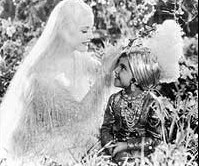
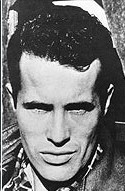
Anger or Sheila Brown?........................ Anger as an adult
If Anger's life is a novel he is writing and rewriting, then he is the unreliable narrator so cherished by literary modernism. There is, however, an actual book, not about himself, but about Hollywood scandals.
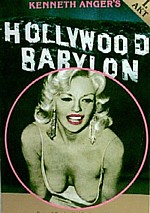
Kenneth Anger's Hollywood Babylon -- first written and published in French, first English edition in 1974 with his name above the title -- is one part Hedda Hopper, one-part Confidential magazine and totally entertaining. A sample of the chapter titles will capture the drift: Panic at Paramount, Heroine Heroines, Saturn Over Sunset, Death Garage, Red Tide, Peep Show Peccadillos, Blood and Soap....It is now published in paperback by Dell (!), complete with the original "black" magic quote: "Every Man and Every Woman Is a Star." This is not a Warholian aphorism, but a Thelema dogma. Thelema is the religion Crowley (1875-1947) concocted; one-part magick (out of Magus John Dee?) and one-part crazy Egyptian download.
Anger's Inauguration of the Pleasure Dome (1954) has Crowleyan romping and posing. The splendidly chaotic Invocation of My Demon Brother (1969) shows Anger himself performing a wizard's ritual, to a soundtrack by Mick Jagger at the Moog. And while we are on the subject, two noteworthy books by Crowley are Diary of a Dope Fiend (1922) and The Book of Lies (1913). Dope Fiend is hilarious, and although it nails down the joys and terrors of cocaine and heroin, in the end the author offers will power as the cure. This from a man who survived on U.K.-legal heroin prescriptions until he died. The Book of Lies, I find impenetrable.
We are not talking Hollywood movies here. Although meticulously "handmade," Anger's films have a density and intensity that make them feel like epics. They have the same relationship to MGM, Warner Brothers, and RKO as poetry does to prose. It is instructive that young Anglemyer - if that really was his name -- chose Anger as his nom de cinema rather than Angel or Angle. The anger shows.
Once you get past the masochistic, pre-Stonewall Fireworks -- inspired, says Anger, by the L.A. Zoot Suit riots (oh, sure) -- and the "documentaries" Scorpio Rising and its sequel fragment, the exquisite, three minute Kustom Kar Kommandos featuring a James Dean youth caressing the chromed engine of his hot rod with a giant powder puff, hold on. You have to have a taste for the occult and for the spectacle of grownups -- some of them quite distinguished -- larking about in odd costumes, occasionally eating jewelry, and staring at you with unblinking eyes.
But I want to focus on Scorpio Rising, certainly one of Anger's masterpieces.

Title: Scorpio Rising, 1964
What Did I Mean to Say?
All the films are now beautifully restored and available on two DVDs from Fantoma, with appreciations by Scorsese, Gus Van Sant, and Guy Maddin, the last previously blessed by Artopia. We have written about Van Sant too. The DVDs come with running commentaries by Anger. Because I have aversion to idle chat, this is an extra I usually avoid. Here though, Anger's recollections are illuminating, but for an unexpected reason. Although the production details are fascinating, what I am really interested in is the gap between the artist's stated intentions and his disturbing results.
In an art world bloated with pompous artist's statements, Artopia usually applies the intentional fallacy, borrowed from Literature 101. Author or artist intent should not apply; it is, to coin a phrase, what's there that's there. I may boast I am making a statement about the cosmos in my poem, my novel, my painting, my film, or my internet essay, but if you and most others see only a monument to egotism, guess who wins?
But this is too simple. In a highly accomplished work, when the gap between intention and reception is really obvious, one can only predicate deception, possession or inspiration. Or all three.
Jack Kerouac in On the Road claimed to be celebrating his devil-may-care band of high-speed, cross-country louts. Those riff-like, winding, jazzy sentences certainly nail down the America of scary highways and endless night. But when you read his prose odes now, you hear the postwar dislocation and despair; it's bebop wry, rootlessness with tears. And the feel and images of things and places is like time travel. He was inspired.
Anger's Scorpio Rising constitutes another complicated case. The filmmaker's detailed "recollections" provide an additional layer of meaning -- as do the viewer's own projections, as does the collective reception, or even as does an occasional vice squad report.
Unless you are privy to the artist's intentions or how the artist reads the work after it's finished, how else will you know when other forces have taken charge? Let's face it, the most valuable new information cannot be intended. The universal internalization of institutional, art-historical, literary and mass-media restrictions sees to that.
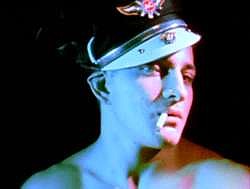
Bruce Byron in Scorpio Rising. Check out the strange ear.
Fallen Angel
From the commentary track I learned Scorpio was shot in Brooklyn when Anger was staying with the underground filmmaker Marie Menken. The bikers in Scorpio were not really hooligans, but Italian-American youths -- complete with ducktails and "dirty foreheads." Most had day jobs at the then thriving Fulton Street fish market in Manhattan. Those were the good old days. Now, whenever I see bikers on the road, I don't think Hell's Angels, I think accountants on a spree.
Anger's bikers hung out with their beloved two-wheelers by the Coney Island Cyclone. The featured stud was the real-life, ex-Marine Bruce Byron, who unlike the others worked as a motorcycle messenger during the day. (The "Byron" was borrowed from James Byron Dean, not Lord Byron.) Byron's cluttered room, with pinups of Marlon Brando and Dean, was his real-life lair. Anger just lovingly filmed it all. But there was, yuk, Anger says, the overwhelming stench of this dreamboat's Siamese cats.
The unbelievable part is that on the commentary track Anger says he was making a documentary. This was a real motorcycle club. These were real Brooklyn bikers --- unlike the sailors in Fireworks who were just film-school students. The bikers agreed to be filmed, even allowing Anger to shoot their Halloween party, during which some are in straight-guy, comic drag -- as opposed to their weekend leather drag. There are a few shots of puking, rampaging. They did, however, insist that their wives and girlfriends, although present, would not be on film. What puritans these leather angels be!
Like the sudden appearance of flying saucers when he was filming the splendiferous Lucifer Rising in Egypt years later, Anger says that The Wild One came on the TV set by accident. He was shooting pretty-boy Byron in his room and the television was on and suddenly there was Brando on the screen. How perfect could that be? As perfect as Crowley always claiming he was from another planet?
Anger also says that the Christian film that he intercut with the deadly chopper run that ends his "documentary" appeared by accident, arriving at the wrong address. Or was it the right address? There are no accidents. Later, the Lutheran Church sued him for using their film, The Last Journey to Jerusalem, but they lost, on grounds of "fair use." Anger claims he told the Lutherans they should have been embarrassed to show such a piece of garbage to their Sunday School captives. He says they stopped using it. Because he had shamed them? Or was it because this silly piece of propaganda was contaminated by Anger's love-death classic?
In some quarters, Scorpio was considered pornographic -- not just homoerotic. A couple of shots of a visitor from Canada are modeled, Anger admits, on Physique Pictorial. There is some cheerful mooning and perhaps a flash-frame penis. Anger loves subliminal edits. Beware!
Scorpio was seized by the L.A. Vice Squad at its premiere in 1964, but later judged as having redeeming social value. And what might that be? Death by chopper spill for dressing up in leather? Punishment for male vanity?
In Scorpio, everything is found fantasy. Only the death is real. Mercifully, you see the spill but not the blood.
A documentary? Give me a break. What he was really doing was deconstructing masculinity. We didn't know that then, but we see it now. At that point, only a California acolyte of Crowley with an out-of-control unconscious, with a sense of irony equal to his distant master, could have achieved such a motorcycle mega-mixture of attraction and repulsion, could have presented the spectacle of Byron adorning himself with leather fetishes to the song Blue Velvet. "She wore blue velvet." She! Anger says he did that intentionally -- letting the feminine pronoun stand -- just as he cut the mustard "testicle-rub" initiation scene to the obscure but lilting ditty Torture. By the way, you see the rub, but not the testicles.
Cocteau predicted that in the future, making a film would be as easy as writing a poem. Anger, in spite of his labor-intensive edits and superimpositions, fulfills that prophesy in Scorpio. He was both cinematographer and editor. And casting director. It is his eye that is caressing the Brooklyn biker boys and their leather and metal accessories. This is why the film is disturbing -- and liberating. It is not simply that Anger captures the nexus of the homosocial and the homoerotic. More important, he displays and preserves his own voyeurism.
By extension, his camera turns everyone who sees the film into a Peeping Tom. To his naïve subjects, the camera may have masked the director's gaze. It also allowed it. Anger's subjects are saying we are dressed this way because it affects other people, inspiring fear. We are dressed this way because it stimulates us sexually and stimulates you.
On the commentary track, Anger insists that his subjects were not paid. Surely it is not to brag that this is not a union production. I think Anger wants us to know his subjects were in on it, at least unconsciously. They liked showing off. They liked another man looking at them. They loved the adoring camera, the lusty lens.
Women like this film and, of course, so do most gay men. It is about masquerade. Heterosexual men will be challenged. You are allowed to look at other men only if they are on the playing field, basketball court or wrestling mat. In Scorpio you are the camera; you get a big dose of male bodies, male attitudes. Or, equally shocking, the sense of being on the other side of the camera, under the gun.
The narcissism of these motorcycle boys was quite easily transformed into exhibitionism. Or were they so besotted with themselves that they couldn't grasp that they were being examined like hunks of meat?
FOR AN AUTOMATIC ARTOPIA ALERT WHEN NEW ENRIES ARE POSTED
CONTACT: perreault@aol.com
AJ Ads
AJ Blogs
AJBlogCentral | rssculture
Terry Teachout on the arts in New York City
Andrew Taylor on the business of arts & culture
rock culture approximately
Laura Collins-Hughes on arts, culture and coverage
Richard Kessler on arts education
Douglas McLennan's blog
Dalouge Smith advocates for the Arts
Art from the American Outback
For immediate release: the arts are marketable
No genre is the new genre
David Jays on theatre and dance
Paul Levy measures the Angles
Judith H. Dobrzynski on Culture
John Rockwell on the arts
Jan Herman - arts, media & culture with 'tude
dance
Apollinaire Scherr talks about dance
Tobi Tobias on dance et al...
jazz
Howard Mandel's freelance Urban Improvisation
Focus on New Orleans. Jazz and Other Sounds
Doug Ramsey on Jazz and other matters...
media
Jeff Weinstein's Cultural Mixology
Martha Bayles on Film...
classical music
Fresh ideas on building arts communities
Greg Sandow performs a book-in-progress
Exploring Orchestras w/ Henry Fogel
Harvey Sachs on music, and various digressions
Bruce Brubaker on all things Piano
Kyle Gann on music after the fact
Greg Sandow on the future of Classical Music
Norman Lebrecht on Shifting Sound Worlds
publishing
Jerome Weeks on Books
Scott McLemee on books, ideas & trash-culture ephemera
theatre
Wendy Rosenfield: covering drama, onstage and off
Chloe Veltman on how culture will save the world
visual
Public Art, Public Space
Regina Hackett takes her Art To Go
John Perreault's art diary
Lee Rosenbaum's Cultural Commentary
Tyler Green's modern & contemporary art blog
